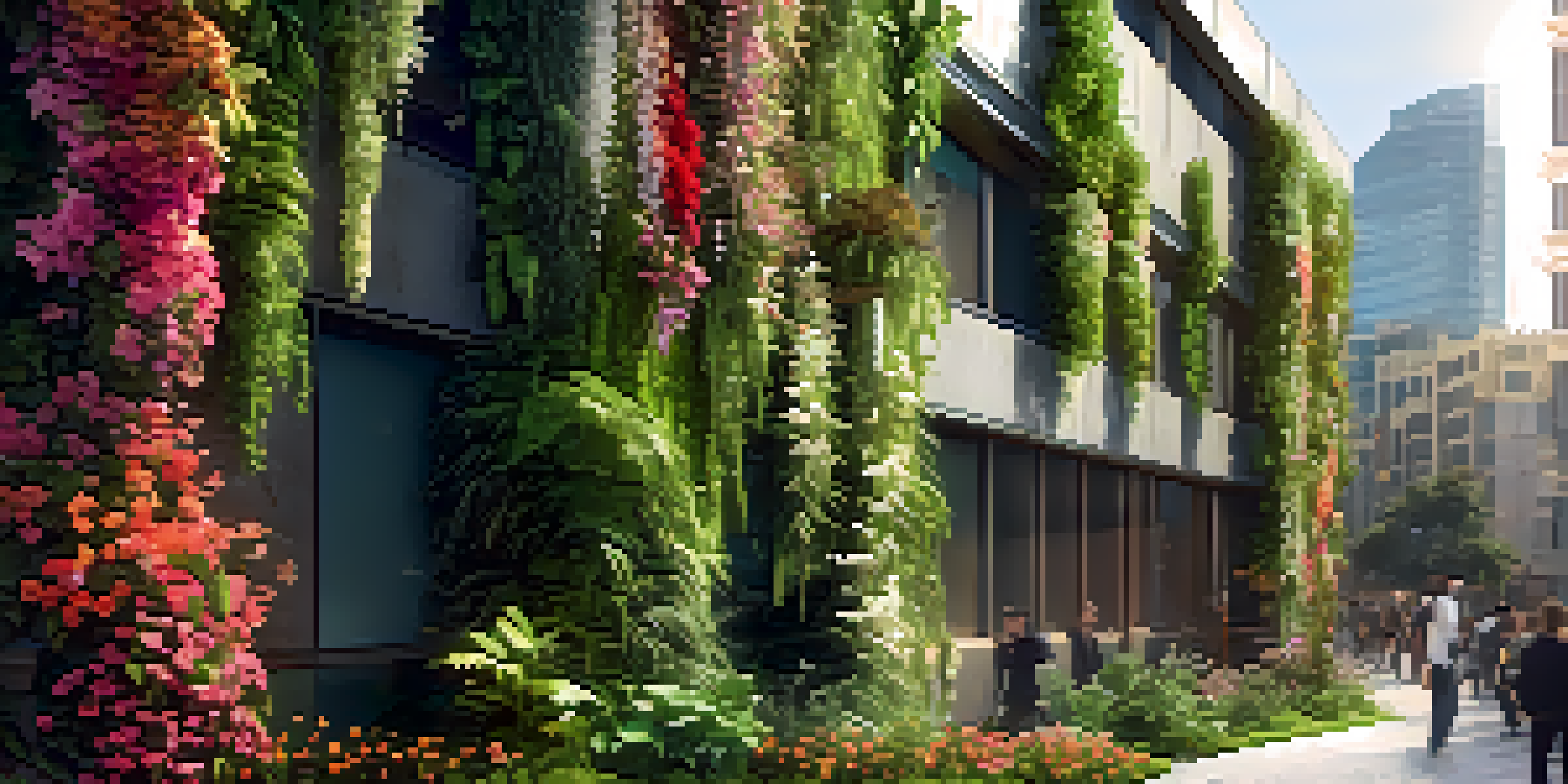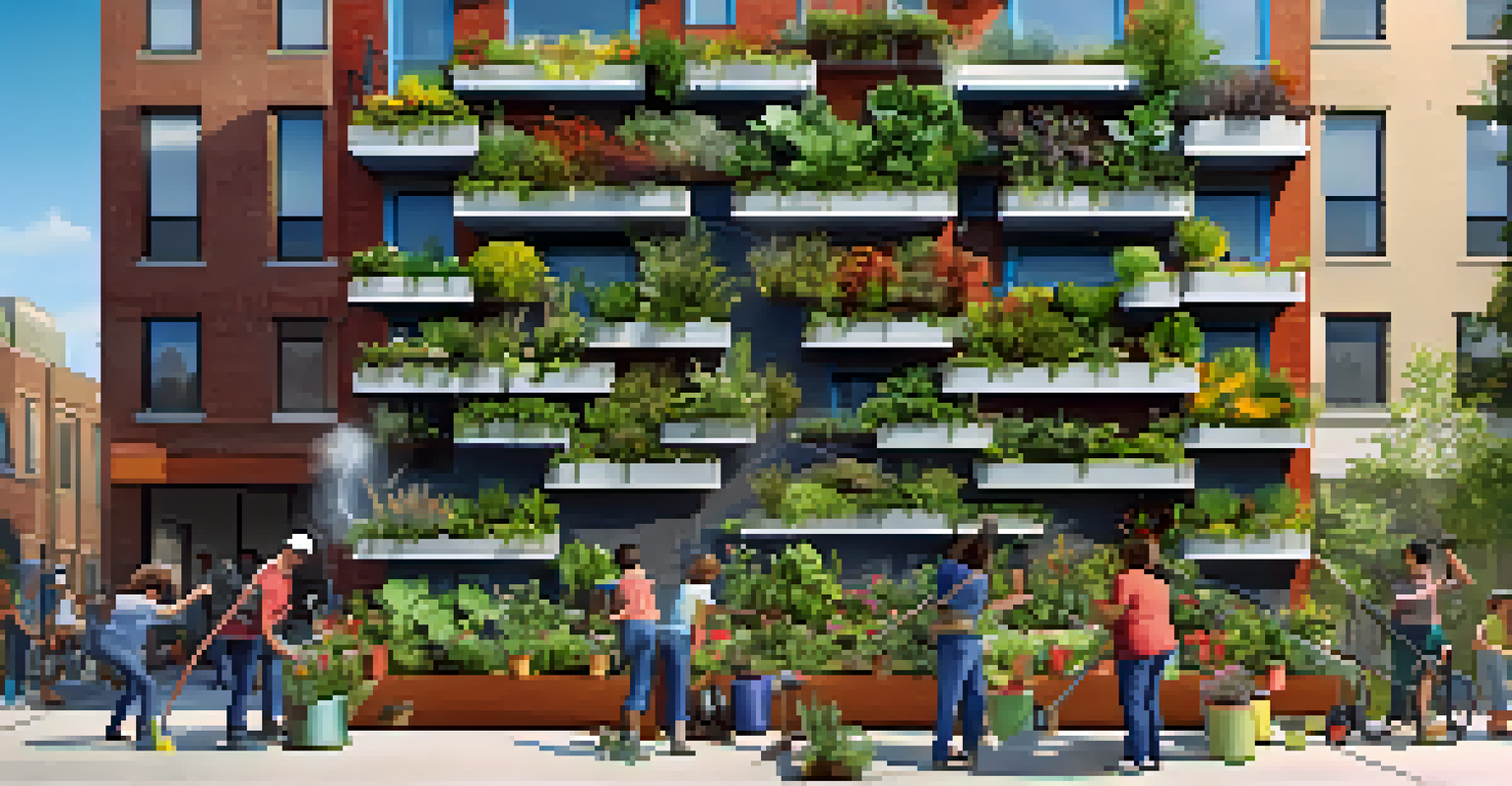Vertical Gardens: Innovative Solutions for Urban Spaces

Understanding Vertical Gardens and Their Benefits
Vertical gardens, also known as living walls, are innovative structures that allow plants to grow vertically on walls. They offer a unique solution to urban spaces where ground area is limited. By utilizing vertical surfaces, these gardens not only beautify buildings but also contribute to improved air quality and biodiversity in cities.
The best time to plant a tree was twenty years ago. The second best time is now.
One of the key benefits of vertical gardens is their ability to mitigate the urban heat island effect. Urban areas tend to be warmer than their rural counterparts due to concrete and asphalt absorbing heat. Vertical gardens help cool these spaces by providing shade and releasing moisture through plant transpiration, creating a more comfortable environment.
Moreover, vertical gardens can enhance building aesthetics and property value. A well-designed green wall can transform a dull façade into a vibrant living canvas, attracting attention and potentially increasing real estate demand in the area.
The Role of Vertical Gardens in Urban Sustainability
In an age where sustainability is paramount, vertical gardens play a critical role in promoting eco-friendly practices. They can be integrated into various urban settings, from residential buildings to commercial properties, helping to reduce overall carbon footprints. By incorporating plant life into our architecture, we can create greener, more sustainable cities.

These gardens also help manage stormwater runoff, a common issue in urban areas. The plants and soil in vertical gardens absorb rainwater, reducing the risk of flooding and minimizing the burden on drainage systems. This natural filtration process contributes to cleaner water and less pollution in our waterways.
Vertical Gardens Boost Urban Greenery
Vertical gardens enhance urban aesthetics and improve air quality by utilizing vertical space for plant growth.
Additionally, vertical gardens can encourage biodiversity by providing habitats for various species, including birds and insects. By introducing greenery into urban landscapes, these gardens create micro-ecosystems that support life and promote ecological balance.
Designing Your Own Vertical Garden: Key Considerations
If you're considering adding a vertical garden to your home or business, there are several important factors to keep in mind. First, assess the location for sunlight exposure, as different plants require varying amounts of light. Choosing the right spot will ensure your garden thrives and flourishes.
Nature does not hurry, yet everything is accomplished.
Next, consider the irrigation system. Vertical gardens can be challenging when it comes to watering, so a reliable irrigation setup is crucial. Options range from simple drip systems to more complex automated solutions, ensuring your plants receive the right amount of moisture without excessive effort.
Lastly, selecting the right plants is essential for a successful vertical garden. Opt for native or drought-resistant species that will adapt well to your local climate. Mix and match textures and colors to create an aesthetically pleasing display that reflects your personal style.
Vertical Gardens: A Solution for Urban Air Quality
Air pollution is a pressing concern in many urban areas, and vertical gardens can help improve air quality. Plants naturally absorb carbon dioxide and release oxygen through photosynthesis, contributing to cleaner air. By incorporating vertical gardens into cities, we can enhance the overall health of urban environments.
Certain plants are particularly effective at filtering out common pollutants, such as formaldehyde and benzene. For instance, species like pothos and spider plants are known for their air-purifying properties. By strategically selecting these plants for your vertical garden, you can create a greener, healthier atmosphere.
Sustainable Solutions for Cities
These gardens help manage stormwater runoff and promote biodiversity, contributing to more sustainable urban environments.
Moreover, vertical gardens can act as sound barriers, reducing noise pollution in bustling urban areas. The combination of plants and soil can absorb sound waves, creating a quieter and more peaceful environment.
Community Engagement Through Vertical Gardens
Vertical gardens are not just about aesthetics; they can also foster community engagement and collaboration. Many urban areas have initiated community garden projects that encourage residents to participate in the design, planting, and maintenance of these green spaces. This collective effort strengthens community bonds and promotes a sense of ownership.
Additionally, educational workshops can be held around vertical gardening techniques, allowing community members to learn about sustainability and horticulture. These workshops can empower individuals to create their own vertical gardens, further spreading the green initiative throughout the neighborhood.
By incorporating community-driven vertical gardens, cities can enhance their social fabric while also addressing environmental concerns. These projects can become gathering spaces, promoting interaction and connection among residents.
The Future of Vertical Gardens in Urban Design
As urbanization continues to grow, the future of vertical gardens looks promising. Architects and urban planners are increasingly recognizing the importance of integrating greenery into their designs. This trend not only enhances the visual appeal of cities but also contributes to sustainable development goals.
Innovative technologies, such as smart irrigation systems and modular planting solutions, are making vertical gardening more accessible and efficient. These advancements allow for easier maintenance and better plant care, attracting more people to embrace this eco-friendly practice.
Community Engagement Through Green Spaces
Vertical gardens foster community involvement and educational opportunities, strengthening social bonds while addressing environmental issues.
Ultimately, vertical gardens represent a shift toward a more sustainable urban lifestyle. As cities evolve, the incorporation of green spaces will be vital in ensuring a healthy, vibrant, and livable environment for generations to come.
Case Studies: Successful Vertical Garden Implementations
Numerous cities worldwide have successfully implemented vertical gardens, showcasing their potential. For instance, the Bosco Verticale in Milan features residential towers adorned with thousands of trees and plants, creating a stunning green oasis in the heart of the city. This project not only enhances aesthetics but also improves air quality and biodiversity.
Another inspiring example is the Green Wall Project in Paris, which aims to transform bare walls into lush green landscapes. This initiative encourages local businesses and residents to participate by planting and maintaining vertical gardens, promoting community involvement and environmental awareness.

These case studies highlight the versatility and impact of vertical gardens, demonstrating how they can be adapted to various urban contexts. They serve as powerful reminders of the positive changes that can occur when we prioritize greenery in our cities.